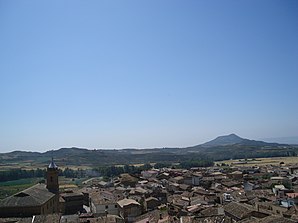Luna (Spain)
| Luna parish | ||
|---|---|---|
 Luna - town view
|
||
| coat of arms | Map of Spain | |

|
|
|
| Basic data | ||
| Autonomous Community : | Aragon | |
| Province : | Zaragoza | |
| Comarca : | Cinco Villas | |
| Coordinates | 42 ° 10 ′ N , 0 ° 56 ′ W | |
| Height : | 477 msnm | |
| Area : | 308.93 km² | |
| Residents : | 698 (Jan. 1, 2019) | |
| Population density : | 2.26 inhabitants / km² | |
| Postal code : | 50610 | |
| Municipality number ( INE ): | 50151 | |
| administration | ||
| Website : | Luna | |
Luna is a northern Spanish town and municipality ( municipio ) with only 698 inhabitants (as of January 1, 2019) in the west of the province of Zaragoza in the north of the autonomous region of Aragon .
Location and climate
The place Luna is on the Río Arba de Biel approx. 67 km (driving distance) north of the provincial capital Saragossa at an altitude of approx. 475 m . The climate is temperate to warm; Rain (approx. 535 mm / year) falls throughout the year, with the exception of the drier summer months.
Population development
| year | 1857 | 1900 | 1950 | 2000 | 2017 |
| Residents | 2,056 | 1,842 | 2,042 | 928 | 726 |
The mechanization of agriculture , the abandonment of small farms and the associated loss of jobs led to a significant decline in population ( rural exodus ) since the middle of the 20th century . The hamlet (pedanía) Lacorvilla , which still has just under 50 inhabitants, also belongs to the community ; the hamlets of Junez and Lacasta have already been abandoned.
economy
For centuries, the residents of the village lived directly or indirectly as self-sufficiency from agriculture, which also included livestock farming. The processing of sheep's wool was an important economic factor in the 16th and 17th centuries. Today fruit trees and viticulture also play important roles in the local economy; In addition, holiday apartments (casas rurales) are rented out.
history
Although the place belonged to the settlement area of the Celtiberian Lusonen , so far neither Celtiberian nor Roman or Visigoth traces have been discovered; however, a Neolithic stele (Estela de Valpalmas) found in the municipality is in the Museo de Zaragoza . In the 8th century Arab-Moorish armies advanced into the upper Ebro Valley. Around the year 1100, the area was recaptured by Alfonso I of Aragon ( reconquista ) ; he handed them over to the Knights Templar . Two remarkable Romanesque churches were built at the end of the 12th century, but not much is known about their background. Later the place and its surroundings came into the hands of the House of Luna .
Attractions
- The castle palace (Castillo Palacio de los Luna) built on the highest point of the place was the Aragonese ancestral seat of the House of Luna . The older east tower, built from rubble stones, collapsed in 1954; the younger west tower from the 14th century has been preserved due to its better construction.
- The single-nave Romanesque Iglesia de Santiago was built around the year 1200. The most striking component is the west facade with its archivolt portal protruding slightly from the line of masonry and a console frieze above it ; a three-window motif and a simple bell gable (espadaña) complete the facade. The barely exposed interior shows a barrel vault with belt arches. There is a crypt under the clearly raised apse . In the 17th / 18th In the 19th century, two side chapels were added.
- The Iglesia San Gil Abad impresses with its precisely assembled masonry; in the keystone of the simple portal is a trinitarian chrismon . The interior of the church shows an extremely rich wall structure with blind arches . The nave is vaulted with a pointed barrel; the apse shows a profiled rib vault .
- Surroundings
- The ruins of another castle (Castillo de Villaverde) are north of the village.
Web links
- Luna, sights - photos + information (Spanish)
Individual evidence
- ↑ Cifras oficiales de población resultantes de la revisión del Padrón municipal a 1 de enero . Population statistics from the Instituto Nacional de Estadística (population update).
- ↑ Luna - climate tables
- ↑ Luna - population development
- ↑ Luna story
- ↑ Luna - Castillo
- ↑ Luna - Castillo
- ^ Luna - Church of Santiago
- ↑ Luna - Church of San Gil


